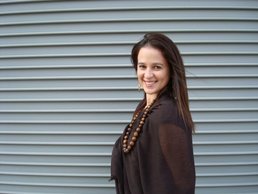About The Artist

Dubhe Carreño was born in Caracas, Venezuela. At 18 years old she came to the United States to pursuit a career in classical dance and to continue her training in ballet. Looking to relieve the stress of the demands of a career in dance she enrolled in a pottery class at the School of the Museum of Fine Arts, Boston. She immediately fell in love with clay and decided to study it in depth, intuitively understanding her affinity with this material’s plasticity; both physically and conceptually and discovering its richness and potential. She enrolled at the Massachusetts College of Art and received her BFA with a concentration in ceramics in 1999 and a MFA from the School of the Art Institute of Chicago in 2001. Upon graduation, Dubhe was hired as an instructor by the School of the Art Institute of Chicago as well as Northeastern Illinois University. Dubhe currently teaches ceramics at Northeastern University.
In 2004 Carreño created the Dubhe Carreño Gallery in Chicago with the primary goal of creating a platform dedicated to contemporary ceramics that illustrated the diversity of concepts being explored by many contemporary artists. For almost ten years the Dubhe Carreño Gallery was known as the prime platform in Chicago for presenting contemporary ceramics by international artists. Dubhe closed her gallery in 2012 after having her first child and missing the direct contact with clay. This created the perfect opportunity to reconnect with her own studio practice which developed into the rediscovery of her passion for functional objects and the meditative quality of the process of working with clay.
"My process is led by clay itself and its natural ability to be altered and transformed by forces ranging from a delicate pinch to a blasting fire. My artistic practice is an extension of my personal growth. The meditative quality of working in the studio brings me closer to being aware of the present moment--when intention materializes in front of my eyes.The name "This Quiet Dust" is a poem by Emily Dickinson which serves as a metaphor for the human condition; we are impermanent in our physical form, yet our true self is transforming and everlasting. Likewise, "this" clay can be transformed from dust to become that which holds our sustenance."
Dubhe Carreño
In 2004 Carreño created the Dubhe Carreño Gallery in Chicago with the primary goal of creating a platform dedicated to contemporary ceramics that illustrated the diversity of concepts being explored by many contemporary artists. For almost ten years the Dubhe Carreño Gallery was known as the prime platform in Chicago for presenting contemporary ceramics by international artists. Dubhe closed her gallery in 2012 after having her first child and missing the direct contact with clay. This created the perfect opportunity to reconnect with her own studio practice which developed into the rediscovery of her passion for functional objects and the meditative quality of the process of working with clay.
"My process is led by clay itself and its natural ability to be altered and transformed by forces ranging from a delicate pinch to a blasting fire. My artistic practice is an extension of my personal growth. The meditative quality of working in the studio brings me closer to being aware of the present moment--when intention materializes in front of my eyes.The name "This Quiet Dust" is a poem by Emily Dickinson which serves as a metaphor for the human condition; we are impermanent in our physical form, yet our true self is transforming and everlasting. Likewise, "this" clay can be transformed from dust to become that which holds our sustenance."
Dubhe Carreño
